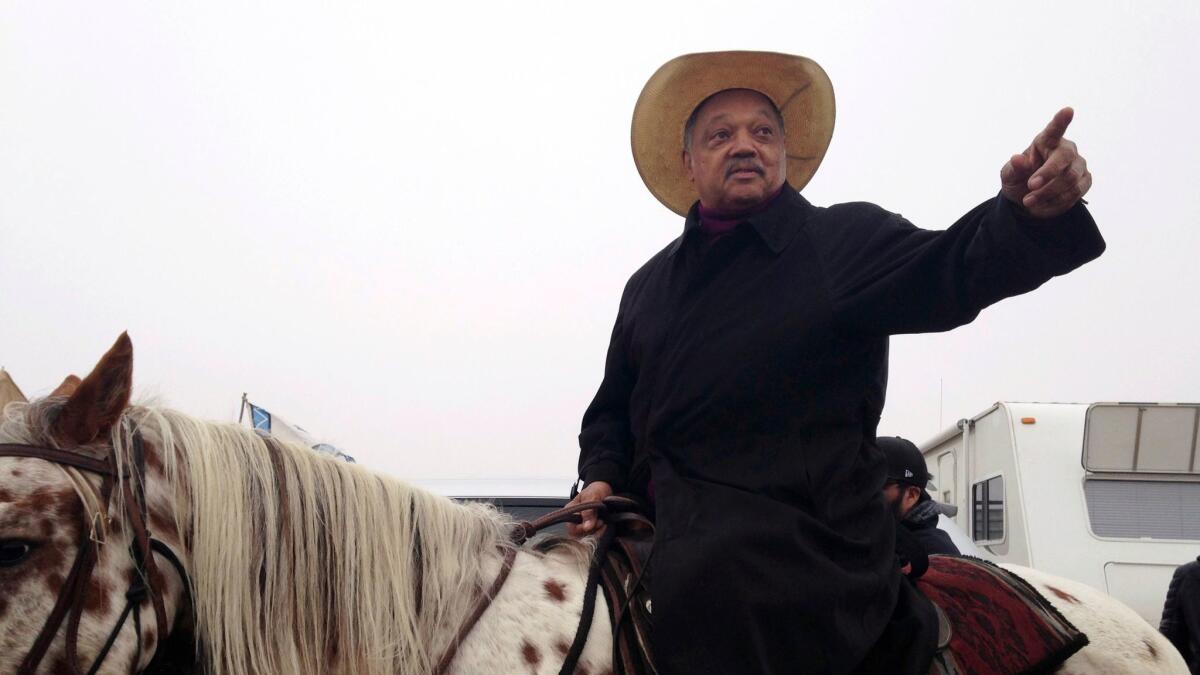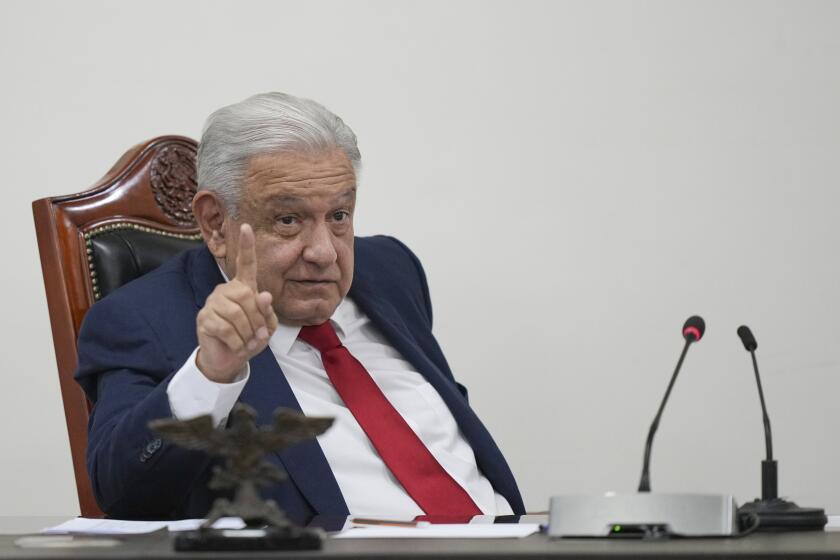Even the Rev. Jesse Jackson on horseback can’t end pipeline showdown

Tensions remained strained as police officials here confronted Native American activists and hundreds of their supporters — including the Rev. Jesse Jackson on horseback — over a pipeline project that has bloomed into a national controversy.
The confrontation took place shortly after dawn Wednesday, in the middle of state highway 1806 north of the Standing Rock reservation. North Dakota county sheriffs, along with representatives of state police and the National Guard, approached the “north gate” of the pipeline protesters – a removable blockade erected just north of their “winter camp.” A few days ago the camp was an empty field but now is dotted with several dozen teepees and about 100 tents. And it all lies in the path of the planned 1,172-mile, $3.78-billion pipeline.
Native American protesters have declared “eminent domain” to reclaim the land, ceded to the Great Sioux Nation in the 1851 Ft. Laramie Treaty but later taken away. The activists’ purpose: to keep the pipeline from crossing the highway and moving farther east, toward the Missouri River, where they say a spill could jeopardize their water supply and that of 17 million other Americans.
But in the early morning cold, as he stood facing protest leaders in the center of an open highway, an angry Cass County Sheriff Paul Laney said the camp was illegally built on private land. The land was purchased recently by Energy Transfer Partners, the Fortune 500 pipeline company intent on finishing the pipeline and beginning to pump upward of 570,000 barrels of oil from northwestern North Dakota to southern Illinois.
State police, aided by a surveillance helicopter owned by the oil company, have acted forcefully against protesters, erecting checkpoints, arresting 126 on Saturday alone and charging many with “engaging in a riot.”
“We don’t work for DAPL [Dakota Access pipeline],” Laney told Mekasi Camp Horinek, a camp coordinator for the Standing Rock tribe. “We work for the citizens of North Dakota. And you are illegally trespassing.”
Laney told Horinek that the dozens of people now residing in “winter camp” must move or face arrest.
“This is a peaceful, prayerful occupation,” Horinek said, citing the 1851 treaty as justification for reclaiming the land. The occupation has received the support of the chairman of the nearby Cheyenne River tribe, and Standing Rock lawyers, Horinek said, were “drawing up papers” to show that every land sale after the 1851 treaty was a breach of the treaty. Therefore, he said, the group was camping on its own land.
“You really believe that?” Laney replied. “So you’d be able to take anyone’s house you want because it’s yours?”
“No,” Horinek replied, his voice rising. “Our people didn’t break the treaties. The government broke the treaties.”
“We do not need to have a confrontation,” Laney said. “Let it be settled in the courts, and nobody gets hurt.”
“We’ll hold our ground, peaceful and prayerful,” Horinek replied. “And if there’s any aggression or violence it will come from your side, not ours.
“It’s not going to be aggression – it’s going to be enforcing the rule of law,” Laney said.
Amid raised voices, repeated interruptions and demands for respect, the two sides reached a standstill.
“We’re not moving,” Horinek said. “We’ll be there waiting for you. Highway 1806 is now a no-surrender line and that camp is no retreat.”
“Is that your final word?” Laney asked, before turning away and vowing to regroup and discuss strategy with officers staged behind a ridge several miles to the north.
There, according to scouting reports from pipeline opponents, some 80 police vehicles were assembled in preparation for a raid on the camp. In an interview as he walked toward his vehicle, Laney declined to discuss “a tactical question.”
But in a separate interview, Morton County Sheriff Kyle Kirchmeier acknowledged a militarized police presence in the ongoing showdown. Kirchmeier defended the use of “MRAP,” or Mine-Resistant Ambush Protected vehicles, built to withstand IED explosions in Iraq, which his office regularly deploys at demonstrations.
“That’s in our regular tool chest,” he said of the mine-resistant vehicles. “That’s what we do to provide safety.”
With the police gone, pipeline opponents began to gather at the camp’s “north gate.” A young Navajo woman laid a red blanket on the road, placing on it a buffalo skull and a coffee can full of burning sage, cedar and wild grass. She sang a prayer, and soon the Rev. Jackson could be seen moving through the circle of pipeline resisters, arm in arm with actor Mark Ruffalo.
“It gets dark sometimes,” Jackson preached, as a tight circle of dozens of pipeline resisters crowded around him, chanting in repetition his every phrase. “But we’ll work by night. For surely as it is dark, the morning cometh. The darkness cannot stand. Weeping may endure for a night, but joy cometh in the morning. It’s morning time. It’s hope time. It’s healing time. It’s Sioux nation time.”
Whoops and cheers rang out. Jackson and Ruffalo then made their way to the main camp a mile south, and the crowd dispersed.
By early afternoon, the chill lifted and the late fall sun began to emerge. Rumors quickly spread that the Obama administration had ordered North Dakota to stand down and — though still only a rumor — not conduct a raid, and though it remained unconfirmed, a palpable relief spread through the several hundred resisters.
During a lunch with Jackson, activist leader Robby Romero asked him to call the White House to request an emergency executive order calling on North Dakota police not to raid the winter camp. In a separate development, Department of Justice officials were said to be planning a meeting with Native camp leaders for early next week.
Horinek, however, remained vigilant. He sat in his truck, two-way radio close at hand, looking north along highway 1806.
Tolan is a special correspondent
More to Read
Sign up for Essential California
The most important California stories and recommendations in your inbox every morning.
You may occasionally receive promotional content from the Los Angeles Times.










